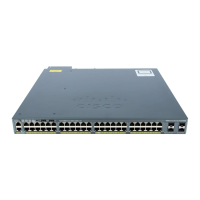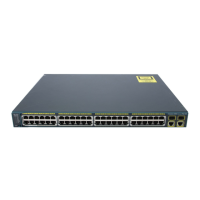Port Priority Versus Path Cost
If a loop occurs, spanning tree uses port priority when selecting an interface to put into the forwarding state.
You can assign higher priority values (lower numerical values) to interfaces that you want selected first and
lower priority values (higher numerical values) that you want selected last. If all interfaces have the same
priority value, spanning tree puts the interface with the lowest interface number in the forwarding state and
blocks the other interfaces.
The spanning-tree path cost default value is derived from the media speed of an interface. If a loop occurs,
spanning tree uses cost when selecting an interface to put in the forwarding state. You can assign lower cost
values to interfaces that you want selected first and higher cost values that you want selected last. If all
interfaces have the same cost value, spanning tree puts the interface with the lowest interface number in the
forwarding state and blocks the other interfaces.
If your switch is a member of a switch stack, you must assign lower cost values to interfaces that you want
selected first and higher cost values that you want selected last instead of adjusting its port priority. For details,
see Related Topics.
Related Topics
Configuring Port Priority, on page 31
Configuring Path Cost, on page 32
Spanning-Tree Interface States
Propagation delays can occur when protocol information passes through a switched LAN. As a result, topology
changes can take place at different times and at different places in a switched network. When an interface
transitions directly from nonparticipation in the spanning-tree topology to the forwarding state, it can create
temporary data loops. Interfaces must wait for new topology information to propagate through the switched
LAN before starting to forward frames. They must allow the frame lifetime to expire for forwarded frames
that have used the old topology.
Each Layer 2 interface on a switch using spanning tree exists in one of these states:
• Blocking—The interface does not participate in frame forwarding.
• Listening—The first transitional state after the blocking state when the spanning tree decides that the
interface should participate in frame forwarding.
• Learning—The interface prepares to participate in frame forwarding.
• Forwarding—The interface forwards frames.
• Disabled—The interface is not participating in spanning tree because of a shutdown port, no link on the
port, or no spanning-tree instance running on the port.
An interface moves through these states:
•
From initialization to blocking
•
From blocking to listening or to disabled
•
From listening to learning or to disabled
•
From learning to forwarding or to disabled
•
From forwarding to disabled
Catalyst 2960-XR Switch Layer 2 Configuration Guide, Cisco IOS Release 15.0(2)EX1
18 OL-29424-01
Configuring Spanning Tree Protocol
Spanning Tree Protocol

